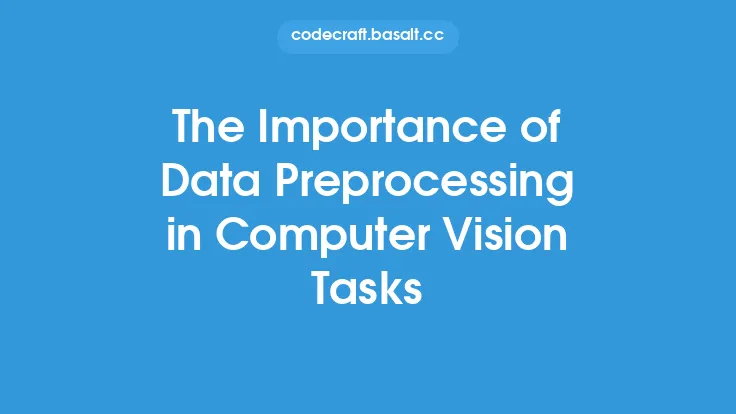Building a computer vision pipeline from scratch requires a thorough understanding of the various components involved in the process. It encompasses a series of steps, from data collection and preprocessing to model training and deployment. The goal of a computer vision pipeline is to enable computers to interpret and understand visual data from the world, allowing them to make informed decisions or take actions based on that understanding.
Introduction to Computer Vision Pipelines
A computer vision pipeline typically consists of several stages, including data ingestion, data preprocessing, model training, model evaluation, and deployment. Each stage plays a critical role in the overall performance of the pipeline. The data ingestion stage involves collecting and storing visual data, such as images or videos, from various sources. This data can come from cameras, sensors, or other devices. The quality and diversity of the data have a significant impact on the accuracy and robustness of the computer vision model.
Data Preprocessing Techniques
Data preprocessing is a crucial step in the computer vision pipeline. It involves cleaning, transforming, and preparing the data for model training. This stage can include tasks such as image resizing, normalization, and data augmentation. Image resizing is necessary to ensure that all images are of the same size, which is required by most deep learning models. Normalization involves scaling the pixel values of the images to a common range, usually between 0 and 1, to prevent features with large ranges from dominating the model. Data augmentation techniques, such as rotation, flipping, and cropping, are used to increase the size of the dataset and improve the model's ability to generalize to new, unseen data.
Model Selection and Training
The next stage in the pipeline is model selection and training. This involves choosing a suitable computer vision model based on the specific task at hand, such as image classification, object detection, or segmentation. The model is then trained on the preprocessed data using a suitable optimization algorithm and loss function. The choice of model and training parameters has a significant impact on the performance of the pipeline. Popular computer vision models include convolutional neural networks (CNNs), recurrent neural networks (RNNs), and transformers. CNNs are particularly well-suited for image classification tasks, while RNNs are often used for tasks that involve sequential data, such as video analysis.
Model Evaluation and Validation
After training the model, the next stage is model evaluation and validation. This involves assessing the performance of the model on a separate test dataset to estimate its accuracy and robustness. Common evaluation metrics for computer vision tasks include accuracy, precision, recall, and F1 score. The model's performance can also be validated using techniques such as cross-validation, which involves training and testing the model on multiple subsets of the data. This helps to ensure that the model is not overfitting or underfitting to the training data.
Deployment and Maintenance
The final stage in the pipeline is deployment and maintenance. This involves deploying the trained model in a production environment, where it can be used to make predictions on new, unseen data. The model may need to be integrated with other systems or applications, such as web or mobile apps, to provide a seamless user experience. Maintenance is also an essential part of the pipeline, as the model may need to be updated or retrained over time to adapt to changes in the data or the task at hand. This can involve monitoring the model's performance, collecting new data, and retraining the model as necessary.
Best Practices for Building Computer Vision Pipelines
Building a computer vision pipeline from scratch requires careful planning and attention to detail. Some best practices to keep in mind include starting with a clear definition of the task or problem to be solved, collecting and preprocessing high-quality data, selecting a suitable model and training parameters, and evaluating and validating the model's performance thoroughly. It's also essential to consider the computational resources and infrastructure required to support the pipeline, including hardware, software, and personnel. By following these best practices and staying up-to-date with the latest advances in computer vision, developers can build robust and accurate pipelines that enable computers to interpret and understand visual data from the world.
Common Challenges and Limitations
Building a computer vision pipeline from scratch can be challenging, and there are several common limitations and challenges to be aware of. These include the need for large amounts of high-quality training data, the risk of overfitting or underfitting, and the challenge of deploying and maintaining the model in a production environment. Additionally, computer vision models can be sensitive to changes in lighting, pose, and other environmental factors, which can affect their accuracy and robustness. By understanding these challenges and limitations, developers can design and implement more effective computer vision pipelines that are capable of achieving high accuracy and robustness in a variety of applications and environments.
Future Directions and Opportunities
The field of computer vision is rapidly evolving, with new advances and breakthroughs being reported regularly. Some future directions and opportunities for computer vision pipelines include the use of transfer learning and few-shot learning to adapt models to new tasks and domains, the development of more efficient and scalable models and training algorithms, and the integration of computer vision with other AI technologies, such as natural language processing and robotics. By staying at the forefront of these advances and developments, developers can build more accurate, robust, and effective computer vision pipelines that have the potential to transform a wide range of applications and industries.





